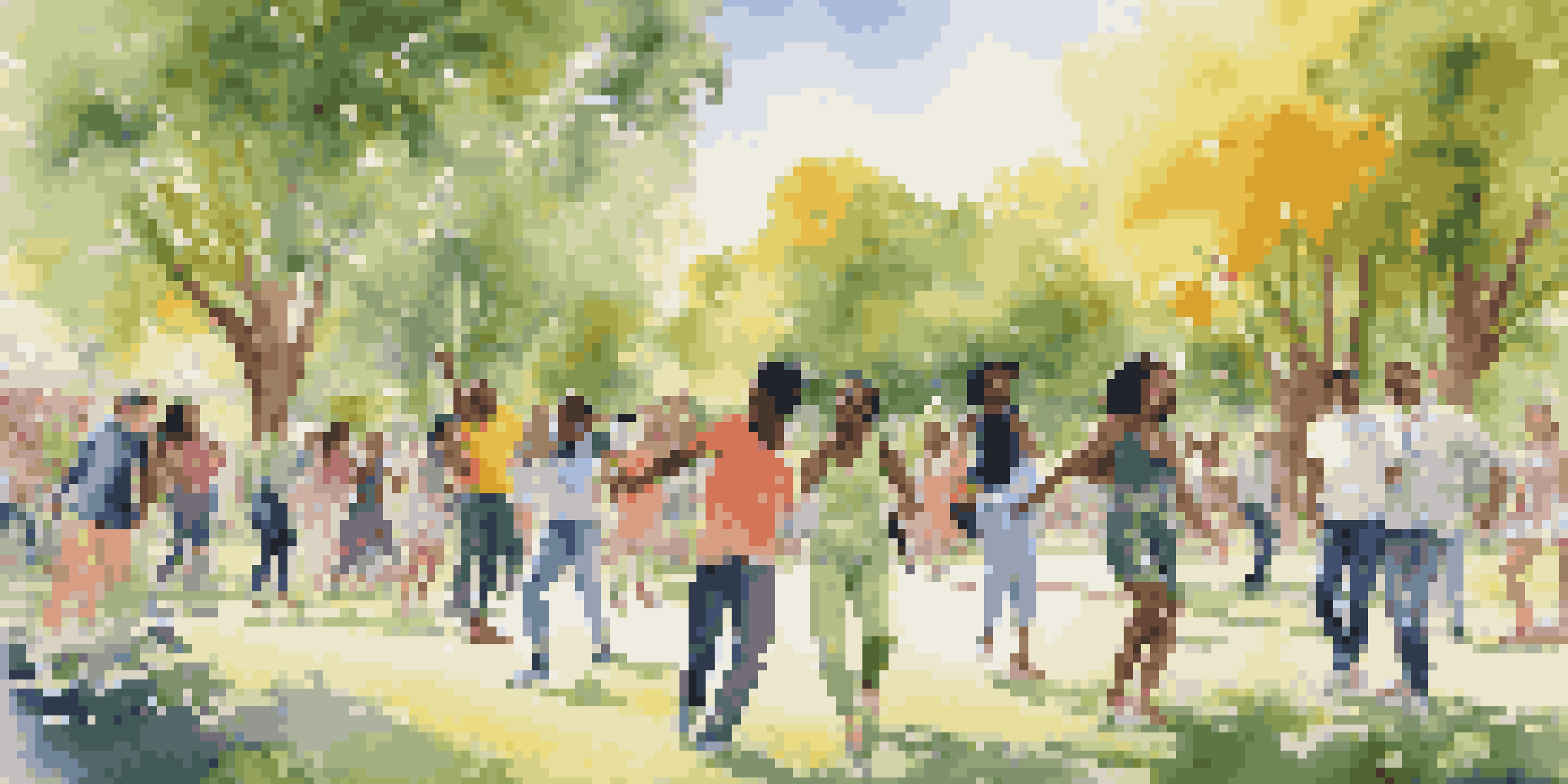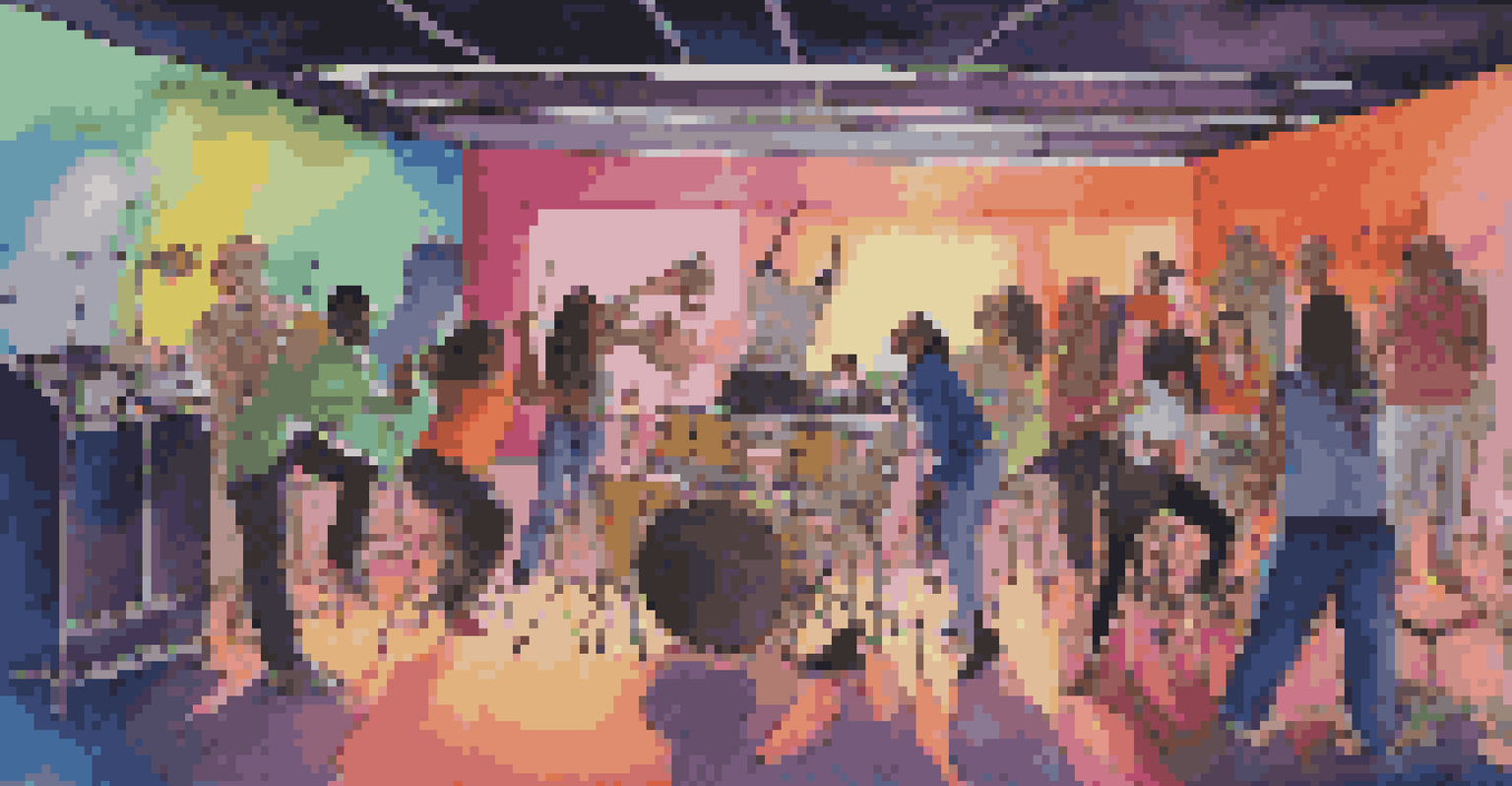The Influence of Music Videos on Youth Identity

How Music Videos Reflect Cultural Trends
Music videos often serve as a mirror to societal norms and values, reflecting what is popular or trending among youth. They showcase fashion, language, and attitudes that resonate with younger audiences, making them feel connected to their peers. For example, a popular music video might highlight a specific style of dress or dance, encouraging viewers to adopt similar trends in their own lives.
Music videos are a visual representation of our culture and can inspire positive change in society.
This reflection isn’t just superficial; it can shape how young people view themselves and their place in the world. When they see artists they admire embodying certain lifestyles or beliefs, it can inspire them to align their identities with those representations. Essentially, music videos become a form of socialization, teaching youth about what is deemed acceptable or desirable in their culture.
By tapping into cultural movements, music videos also play a role in shaping collective youth identity. They can spark conversations about issues like gender, race, and self-expression, giving young viewers a platform to explore these topics within their own lives.
The Role of Artists as Role Models
In the eyes of young audiences, artists often transcend their musical roles, becoming influential figures or role models. Their behavior, choices, and the messages they convey in music videos can significantly impact how youth perceive themselves and others. For instance, when an artist promotes self-love and acceptance through their video, it can inspire fans to embrace their own identities.

However, this influence can be a double-edged sword. While many artists advocate for positive change, others may glamorize harmful behaviors, such as substance abuse or unrealistic beauty standards. This creates a complex landscape where young viewers must navigate the messages they receive, often leading to internal conflicts about their own values and choices.
Music Videos Shape Youth Identity
Music videos reflect and influence societal norms, impacting how young people perceive themselves and their roles in the world.
It's crucial for young people to critically engage with the content they consume. By fostering discussions about the implications of artists' portrayals in music videos, parents and educators can help youth discern positive role models from negative influences.
The Impact of Visual Aesthetics on Self-Image
The visual elements of music videos—color schemes, lighting, and cinematography—can profoundly affect how young viewers perceive beauty and self-worth. Aesthetic choices often set standards that may not be achievable for the average person, leading to comparisons and dissatisfaction. For example, when a video showcases flawless models in stunning settings, it can create unrealistic ideals for young viewers.
Artists have the power to shape perceptions and influence youth through their music and visuals.
This constant exposure can contribute to issues like low self-esteem and body image concerns, as youth may feel pressured to conform to these ideals. The desire to emulate what they see can lead to unhealthy behaviors, such as extreme dieting or the use of cosmetics to fit a perceived standard. In this way, music videos can inadvertently contribute to a cycle of self-criticism and aspiration.
Encouraging discussions about self-image and media literacy is vital in this context. By helping youth understand that music videos often portray a curated version of reality, we can empower them to appreciate their unique qualities and resist the urge to conform to unrealistic standards.
Music Videos and Social Issues Awareness
Many contemporary music videos address pressing social issues, from mental health awareness to social justice movements. This can be a powerful tool for educating and mobilizing youth, as they relate to the artists' messages and feel inspired to take action. For instance, a video that discusses mental health struggles can help normalize these conversations, making it easier for young viewers to seek help.
By showcasing these themes, music videos can also foster a sense of community among viewers who share similar experiences. This shared understanding can promote empathy and solidarity, encouraging young people to support one another in navigating challenges. For example, a video that highlights the struggles of marginalized communities can inspire discussions and advocacy among viewers.
Artists as Influential Role Models
The behavior and messages conveyed by artists in music videos can significantly affect the self-image and choices of young audiences.
It’s essential for artists to thoughtfully approach these topics, as the impact of their messages can be significant. When done well, music videos can serve as catalysts for change, motivating youth to engage with societal issues in meaningful ways.
The Evolution of Music Video Platforms
With the rise of platforms like YouTube and TikTok, music videos have become more accessible than ever, shaping youth culture in real-time. These platforms allow for instant sharing and feedback, meaning trends can emerge and evolve rapidly. This constant influx of content can significantly influence what young people consider cool or relevant.
Moreover, the interactivity of these platforms allows youth to engage directly with the content, creating a sense of ownership over their media consumption. They can comment, share, and remix content, which fosters a participatory culture that empowers them to be creators rather than just consumers. This shift can enhance their sense of identity as they contribute to the narratives they care about.
However, this accessibility also poses challenges, as the sheer volume of content can lead to information overload. Young viewers may struggle to discern quality content from superficial trends, making it crucial for them to develop critical thinking skills regarding the media they consume.
The Global Reach of Music Videos
Music videos transcend geographical boundaries, introducing youth to diverse cultures and ideas from around the world. This global reach can broaden perspectives, allowing young viewers to appreciate different lifestyles and traditions. For instance, K-pop music videos have gained immense popularity outside of South Korea, influencing fashion and music trends globally.
Exposure to various cultures through music videos can foster inclusivity and understanding among youth. When they see artists from different backgrounds collaborating, it sends a powerful message about unity and diversity. This can inspire young people to embrace multiculturalism and challenge stereotypes within their own communities.
Global Exposure Through Music Videos
Music videos provide youth with a window into diverse cultures, promoting inclusivity while also necessitating a critical understanding of cultural representation.
However, it’s important to approach this globalization critically. While music videos can celebrate diversity, they can also perpetuate cultural appropriation if not handled with care. Encouraging discussions about cultural sensitivity can help youth navigate these complexities and foster a more respectful understanding of global influences.
Encouraging Positive Engagement with Music Videos
To harness the positive influence of music videos, it's crucial to encourage youth to engage thoughtfully with the content they consume. Parents and educators can facilitate discussions about the messages portrayed in videos, prompting young viewers to reflect on their values and beliefs. This can empower them to make informed choices about the media they interact with.
Creating space for youth to express their interpretations of music videos can also foster critical thinking. Whether through art, writing, or discussions, these activities allow young people to process what they see and share their perspectives. This active engagement can lead to deeper understanding and personal growth.

Additionally, promoting media literacy programs can equip youth with the skills to critically analyze music videos. By understanding the techniques used to create these videos and the messages they convey, young viewers can become more discerning consumers of media, ultimately shaping their identities in a positive way.